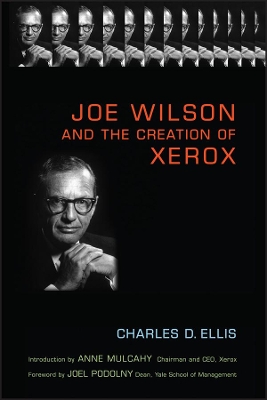Art and Science of Technology Transfer
 -15%
portes grátis
-15%
portes grátis
Art and Science of Technology Transfer
Speser, Phyllis L.
John Wiley & Sons Inc
05/2006
416
Dura
Inglês
9780471707271
15 a 20 dias
838
Descrição não disponível.
Acknowledgments xiii
About the Author xv
Preface xvii
Introduction xxi
Part One The Game of Technology Transfer
Chapter 1 The Pieces 3
Introduction 3
The Problem with Models about Human Behavior 4
Constructs 6
Portraying Constructs 7
Deals 7
Technologies 15
Practices 23
Players 33
Conclusion 38
Chapter 2 The Board 39
Introduction 39
Arenas 39
Channels and Messages 42
Supply Chains 44
Users and Buyers 48
Competitors 55
Markets 59
Stakeholders 64
Conclusion 67
Chapter 3 Strategies 69
Introduction 69
Technology Niches 70
Nash Equilibriums 72
Making Technology Conducive for Nash Equilibriums 74
Objectives 85
Tactics 96
Competition 99
Windows of Opportunity or Being Just-in-Time 100
Conclusion 102
Part Two Market Research
Chapter 4 Finding the Customer 105
Introduction 105
What We Have to Sell 105
Functionality 105
Characteristics 114
Features 117
Product, Process, or Service 118
Finding the Application 121
Finding the Customer 133
The End User 133
Buyers 139
Conclusion 144
Appendix A: Intellectual Property 146
Patents 147
Trade Secrets 149
Trademarks 149
Copyrights and Masks 150
IP Control 150
Chapter 5 Competing Technology 155
Introduction 155
Redundancy 156
Relation to the Dominant Design 159
Who Is Selling? 163
Who Is Emerging? 165
Time 167
Conclusion 171
Chapter 6 Markets 173
Introduction 173
Market Barriers 174
Market Forces 180
Estimating Market Size 189
Estimating Market Share 197
Conclusion 200
Part Three Strategy
Chapter 7 Positioning the Technology for the End User 203
Introduction 203
Take-Off 204
Umpf 205
Goals 209
Competitive Advantage 214
Performance 216
Ease of Use 219
Price 223
Time 227
Window of Opportunity 228
Value Propositions 232
Conclusion 235
Appendix A: Technikos 237
Using Web Search to Develop and Test Hypotheses 237
Interviewing to Test Hypotheses 240
Appendix B: Presenting Your Technology 242
Pre-Nondisclosure 242
Post-Nondisclosure (But Pre-Deal) 242
Investor Presentations 243
Post-Deal (Fully Executed Contract) 243
Chapter 8 Launch Tactics 245
Introduction 245
SWOTs 246
1. Pick the Positioning 248
2. Determine the Strengths and Weaknesses 249
3. Determine the Opportunities and Threats 251
4. Look at the Intersection 254
Looking Forward: Launch Tactics and Finding the Target 260
Channels and Messages 262
Rhetoric and Messages 265
Conclusion 267
Part Four Doing Deals
Chapter 9 Finding the Target 271
Introduction 271
Market Alignment 272
Technology Alignment 282
Alignment on Capabilities 290
Attitude toward Risk 291
Conclusion 294
Chapter 10 Valuing the Technology 295
The Basics: Discounted Cash Flow 296
Approaches to Valuation 297
Not Stupid Methods 297
Stupid Methods 300
Non-Revenue Value and Its Valuation 301
Revenues 302
Expenses 310
Quick Recap 314
Risk 315
Conclusion 324
Appendix A: Why Real Options Are a Waste of Time 326
Chapter 11 Doing the Deal 329
Planning for Negotiations 332
Relationships 333
Intellectual Asset Package 341
Economics 344
Planning the Game in Extensive Form 349
Negotiating 351
Setting the Stage 351
Pulling It Off 356
Conclusion 360
Chapter 12 The Twelve-Step Program 363
Index 369
About the Author xv
Preface xvii
Introduction xxi
Part One The Game of Technology Transfer
Chapter 1 The Pieces 3
Introduction 3
The Problem with Models about Human Behavior 4
Constructs 6
Portraying Constructs 7
Deals 7
Technologies 15
Practices 23
Players 33
Conclusion 38
Chapter 2 The Board 39
Introduction 39
Arenas 39
Channels and Messages 42
Supply Chains 44
Users and Buyers 48
Competitors 55
Markets 59
Stakeholders 64
Conclusion 67
Chapter 3 Strategies 69
Introduction 69
Technology Niches 70
Nash Equilibriums 72
Making Technology Conducive for Nash Equilibriums 74
Objectives 85
Tactics 96
Competition 99
Windows of Opportunity or Being Just-in-Time 100
Conclusion 102
Part Two Market Research
Chapter 4 Finding the Customer 105
Introduction 105
What We Have to Sell 105
Functionality 105
Characteristics 114
Features 117
Product, Process, or Service 118
Finding the Application 121
Finding the Customer 133
The End User 133
Buyers 139
Conclusion 144
Appendix A: Intellectual Property 146
Patents 147
Trade Secrets 149
Trademarks 149
Copyrights and Masks 150
IP Control 150
Chapter 5 Competing Technology 155
Introduction 155
Redundancy 156
Relation to the Dominant Design 159
Who Is Selling? 163
Who Is Emerging? 165
Time 167
Conclusion 171
Chapter 6 Markets 173
Introduction 173
Market Barriers 174
Market Forces 180
Estimating Market Size 189
Estimating Market Share 197
Conclusion 200
Part Three Strategy
Chapter 7 Positioning the Technology for the End User 203
Introduction 203
Take-Off 204
Umpf 205
Goals 209
Competitive Advantage 214
Performance 216
Ease of Use 219
Price 223
Time 227
Window of Opportunity 228
Value Propositions 232
Conclusion 235
Appendix A: Technikos 237
Using Web Search to Develop and Test Hypotheses 237
Interviewing to Test Hypotheses 240
Appendix B: Presenting Your Technology 242
Pre-Nondisclosure 242
Post-Nondisclosure (But Pre-Deal) 242
Investor Presentations 243
Post-Deal (Fully Executed Contract) 243
Chapter 8 Launch Tactics 245
Introduction 245
SWOTs 246
1. Pick the Positioning 248
2. Determine the Strengths and Weaknesses 249
3. Determine the Opportunities and Threats 251
4. Look at the Intersection 254
Looking Forward: Launch Tactics and Finding the Target 260
Channels and Messages 262
Rhetoric and Messages 265
Conclusion 267
Part Four Doing Deals
Chapter 9 Finding the Target 271
Introduction 271
Market Alignment 272
Technology Alignment 282
Alignment on Capabilities 290
Attitude toward Risk 291
Conclusion 294
Chapter 10 Valuing the Technology 295
The Basics: Discounted Cash Flow 296
Approaches to Valuation 297
Not Stupid Methods 297
Stupid Methods 300
Non-Revenue Value and Its Valuation 301
Revenues 302
Expenses 310
Quick Recap 314
Risk 315
Conclusion 324
Appendix A: Why Real Options Are a Waste of Time 326
Chapter 11 Doing the Deal 329
Planning for Negotiations 332
Relationships 333
Intellectual Asset Package 341
Economics 344
Planning the Game in Extensive Form 349
Negotiating 351
Setting the Stage 351
Pulling It Off 356
Conclusion 360
Chapter 12 The Twelve-Step Program 363
Index 369
Este título pertence ao(s) assunto(s) indicados(s). Para ver outros títulos clique no assunto desejado.
art; complicated; context; throughout; technology; next professions; represents; transfer; studied awareness; market; value; great read; tools; focus; profession; hopkins; university; johns; transferthe
Acknowledgments xiii
About the Author xv
Preface xvii
Introduction xxi
Part One The Game of Technology Transfer
Chapter 1 The Pieces 3
Introduction 3
The Problem with Models about Human Behavior 4
Constructs 6
Portraying Constructs 7
Deals 7
Technologies 15
Practices 23
Players 33
Conclusion 38
Chapter 2 The Board 39
Introduction 39
Arenas 39
Channels and Messages 42
Supply Chains 44
Users and Buyers 48
Competitors 55
Markets 59
Stakeholders 64
Conclusion 67
Chapter 3 Strategies 69
Introduction 69
Technology Niches 70
Nash Equilibriums 72
Making Technology Conducive for Nash Equilibriums 74
Objectives 85
Tactics 96
Competition 99
Windows of Opportunity or Being Just-in-Time 100
Conclusion 102
Part Two Market Research
Chapter 4 Finding the Customer 105
Introduction 105
What We Have to Sell 105
Functionality 105
Characteristics 114
Features 117
Product, Process, or Service 118
Finding the Application 121
Finding the Customer 133
The End User 133
Buyers 139
Conclusion 144
Appendix A: Intellectual Property 146
Patents 147
Trade Secrets 149
Trademarks 149
Copyrights and Masks 150
IP Control 150
Chapter 5 Competing Technology 155
Introduction 155
Redundancy 156
Relation to the Dominant Design 159
Who Is Selling? 163
Who Is Emerging? 165
Time 167
Conclusion 171
Chapter 6 Markets 173
Introduction 173
Market Barriers 174
Market Forces 180
Estimating Market Size 189
Estimating Market Share 197
Conclusion 200
Part Three Strategy
Chapter 7 Positioning the Technology for the End User 203
Introduction 203
Take-Off 204
Umpf 205
Goals 209
Competitive Advantage 214
Performance 216
Ease of Use 219
Price 223
Time 227
Window of Opportunity 228
Value Propositions 232
Conclusion 235
Appendix A: Technikos 237
Using Web Search to Develop and Test Hypotheses 237
Interviewing to Test Hypotheses 240
Appendix B: Presenting Your Technology 242
Pre-Nondisclosure 242
Post-Nondisclosure (But Pre-Deal) 242
Investor Presentations 243
Post-Deal (Fully Executed Contract) 243
Chapter 8 Launch Tactics 245
Introduction 245
SWOTs 246
1. Pick the Positioning 248
2. Determine the Strengths and Weaknesses 249
3. Determine the Opportunities and Threats 251
4. Look at the Intersection 254
Looking Forward: Launch Tactics and Finding the Target 260
Channels and Messages 262
Rhetoric and Messages 265
Conclusion 267
Part Four Doing Deals
Chapter 9 Finding the Target 271
Introduction 271
Market Alignment 272
Technology Alignment 282
Alignment on Capabilities 290
Attitude toward Risk 291
Conclusion 294
Chapter 10 Valuing the Technology 295
The Basics: Discounted Cash Flow 296
Approaches to Valuation 297
Not Stupid Methods 297
Stupid Methods 300
Non-Revenue Value and Its Valuation 301
Revenues 302
Expenses 310
Quick Recap 314
Risk 315
Conclusion 324
Appendix A: Why Real Options Are a Waste of Time 326
Chapter 11 Doing the Deal 329
Planning for Negotiations 332
Relationships 333
Intellectual Asset Package 341
Economics 344
Planning the Game in Extensive Form 349
Negotiating 351
Setting the Stage 351
Pulling It Off 356
Conclusion 360
Chapter 12 The Twelve-Step Program 363
Index 369
About the Author xv
Preface xvii
Introduction xxi
Part One The Game of Technology Transfer
Chapter 1 The Pieces 3
Introduction 3
The Problem with Models about Human Behavior 4
Constructs 6
Portraying Constructs 7
Deals 7
Technologies 15
Practices 23
Players 33
Conclusion 38
Chapter 2 The Board 39
Introduction 39
Arenas 39
Channels and Messages 42
Supply Chains 44
Users and Buyers 48
Competitors 55
Markets 59
Stakeholders 64
Conclusion 67
Chapter 3 Strategies 69
Introduction 69
Technology Niches 70
Nash Equilibriums 72
Making Technology Conducive for Nash Equilibriums 74
Objectives 85
Tactics 96
Competition 99
Windows of Opportunity or Being Just-in-Time 100
Conclusion 102
Part Two Market Research
Chapter 4 Finding the Customer 105
Introduction 105
What We Have to Sell 105
Functionality 105
Characteristics 114
Features 117
Product, Process, or Service 118
Finding the Application 121
Finding the Customer 133
The End User 133
Buyers 139
Conclusion 144
Appendix A: Intellectual Property 146
Patents 147
Trade Secrets 149
Trademarks 149
Copyrights and Masks 150
IP Control 150
Chapter 5 Competing Technology 155
Introduction 155
Redundancy 156
Relation to the Dominant Design 159
Who Is Selling? 163
Who Is Emerging? 165
Time 167
Conclusion 171
Chapter 6 Markets 173
Introduction 173
Market Barriers 174
Market Forces 180
Estimating Market Size 189
Estimating Market Share 197
Conclusion 200
Part Three Strategy
Chapter 7 Positioning the Technology for the End User 203
Introduction 203
Take-Off 204
Umpf 205
Goals 209
Competitive Advantage 214
Performance 216
Ease of Use 219
Price 223
Time 227
Window of Opportunity 228
Value Propositions 232
Conclusion 235
Appendix A: Technikos 237
Using Web Search to Develop and Test Hypotheses 237
Interviewing to Test Hypotheses 240
Appendix B: Presenting Your Technology 242
Pre-Nondisclosure 242
Post-Nondisclosure (But Pre-Deal) 242
Investor Presentations 243
Post-Deal (Fully Executed Contract) 243
Chapter 8 Launch Tactics 245
Introduction 245
SWOTs 246
1. Pick the Positioning 248
2. Determine the Strengths and Weaknesses 249
3. Determine the Opportunities and Threats 251
4. Look at the Intersection 254
Looking Forward: Launch Tactics and Finding the Target 260
Channels and Messages 262
Rhetoric and Messages 265
Conclusion 267
Part Four Doing Deals
Chapter 9 Finding the Target 271
Introduction 271
Market Alignment 272
Technology Alignment 282
Alignment on Capabilities 290
Attitude toward Risk 291
Conclusion 294
Chapter 10 Valuing the Technology 295
The Basics: Discounted Cash Flow 296
Approaches to Valuation 297
Not Stupid Methods 297
Stupid Methods 300
Non-Revenue Value and Its Valuation 301
Revenues 302
Expenses 310
Quick Recap 314
Risk 315
Conclusion 324
Appendix A: Why Real Options Are a Waste of Time 326
Chapter 11 Doing the Deal 329
Planning for Negotiations 332
Relationships 333
Intellectual Asset Package 341
Economics 344
Planning the Game in Extensive Form 349
Negotiating 351
Setting the Stage 351
Pulling It Off 356
Conclusion 360
Chapter 12 The Twelve-Step Program 363
Index 369
Este título pertence ao(s) assunto(s) indicados(s). Para ver outros títulos clique no assunto desejado.











